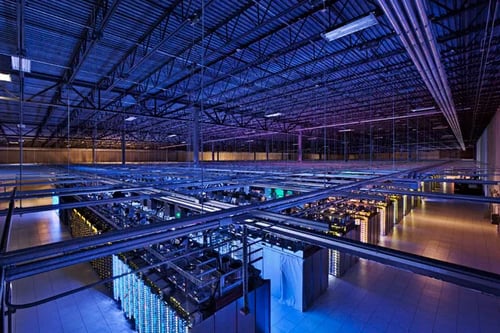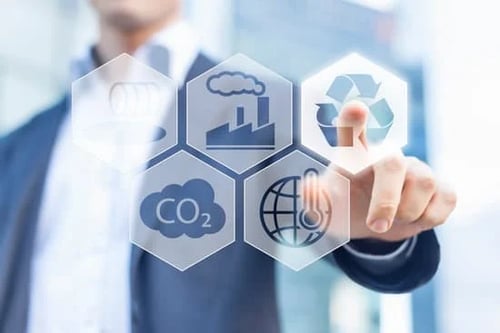Sustainable Data Centers: Benefits for Companies and the Environment

On their own, energy efficiency, water conservation, and a lower carbon footprint combine to make a compelling argument for designing and building sustainable data centers.
The business case for sustainable data centers, however, is that they are not just good for the environment and good for the overall health of communities, but they are good for companies.
Energy-Efficient Data Centers Make Financial Sense
Optimizing energy usage alone makes financial sense for companies, according to the Center for Expertise of Energy Efficiency in Data Centers (CoE) at the Lawrence Berkely National Laboratory.
“The energy intensity of data centers means that energy efficiency improvements have the potential to deliver substantial energy (and monetary) savings to an organization,” says the CoE. “Data center operational costs are often driven by energy consumption and can be extremely expensive, with estimates that the electrical costs for large data centers running in the millions. It’s no wonder then, that 92 percent of companies report being influenced by operational savings in their decision to pursue energy efficiency projects.”
In the CoE publication “Building the Business Case for Energy Efficiency in Data Centers”, the drivers for sustainable data centers include:
- Reduce operating costs: Energy-efficient practices result in reduced operating costs, leading to long-term financial savings for data center operators.
- Increase data center reliability and resiliency: While there can be the perception that energy efficiency is at odds with resiliency and reliability, they can work synergistically. Energy efficiency measures can extend the life of existing facilities and reduce outages.
- Free up data center capacity: Even when the electricity supply is maxed out, energy efficiency can provide a way to increase a data center’s effective capacity (and/or cooling capacity). Energy efficiency can result in improved computing performance per kilowatt, and consolidating data centers and equipment can free up floor space and reduce infrastructure complexity, physical constraints, and staffing requirements.
- Comply with codes and standards: Energy codes and standards play an increasing role in data centers, particularly in new construction or major retrofits.
- Save energy in accordance with organizational values: Taking meaningful steps towards energy conservation is a way that organizations today are demonstrating their commitment to corporate social responsibility to consumers. This commitment can improve a company’s public image as well as employee morale.
- Leverage utility and other incentives: Utilities, state energy offices, and other entities are critical partners in disseminating energy efficiency information, opportunities, and incentives for the marketplace.
- Address aging facility and IT equipment infrastructure: As data center equipment becomes old and obsolete, or begins to break down, there is the opportunity to replace it with newer, more efficient products.
“Energy efficiency improvements stand to significantly reduce energy costs in data centers. Larger investments can result in energy savings of 40 percent or more. Many organizations have found that operational savings outweigh the upfront capital investment required by a wide margin, with low (under a year) payback periods and notable energy cost savings over the lifetime of the equipment,” says the CoE report.
Cost Savings Achieved by Sustainable Practices in Data Centers
The most compelling argument for the business case of sustainable data centers is the cost savings that can be reaped by businesses.
Here’s a look at where companies can look to save and gain:
- Reduced energy costs:
- Adopting energy-efficient hardware, such as low-power servers and solid-state drives (SSDs), can significantly reduce energy consumption and associated costs.
- Implementing advanced cooling systems, like liquid cooling or hot-aisle/cold-aisle containment, can minimize the energy required for cooling, which often accounts for a significant portion of a data center's energy expenses.
- Utilizing renewable energy sources, such as solar or wind power, can reduce reliance on grid electricity and provide long-term cost savings.
- Adopting energy-efficient hardware, such as low-power servers and solid-state drives (SSDs), can significantly reduce energy consumption and associated costs.
- Lower maintenance and replacement costs:
- Sustainable data centers often use modular, scalable designs that allow for easier maintenance and upgrades, reducing associated labor and hardware costs.
- Energy-efficient equipment tends to have a longer lifespan, reducing the frequency and cost of replacements.
- Sustainable data centers often use modular, scalable designs that allow for easier maintenance and upgrades, reducing associated labor and hardware costs.
- Reduced water costs:
- Implementing water-efficient cooling systems, like air-side economizers or liquid cooling, can significantly reduce water consumption and associated costs compared to traditional chiller-based systems.
- Rainwater harvesting or greywater recycling systems can further reduce water costs by utilizing non-potable water sources for cooling purposes.
- Implementing water-efficient cooling systems, like air-side economizers or liquid cooling, can significantly reduce water consumption and associated costs compared to traditional chiller-based systems.
- Avoided regulatory fines and penalties:
- As environmental regulations become more stringent, sustainable data centers are better positioned to comply with these standards, avoiding costly fines and penalties.
- In some cases, sustainable practices may even qualify data centers for tax incentives or rebates, providing additional cost savings.
- As environmental regulations become more stringent, sustainable data centers are better positioned to comply with these standards, avoiding costly fines and penalties.
- Reduced real estate costs:
- Sustainable data centers often have a smaller physical footprint due to their efficient design and layout, which can lead to lower real estate costs.
- In some cases, sustainable data centers can be in areas with lower real estate costs, such as rural areas with access to renewable energy sources.
- Sustainable data centers often have a smaller physical footprint due to their efficient design and layout, which can lead to lower real estate costs.
- Operational efficiency savings:
- Sustainable data centers are designed to optimize power distribution and cooling, reducing the risk of downtime and associated costs.
- Predictive maintenance and monitoring systems can identify potential issues before they cause downtime, further reducing operational costs.
- Sustainable data centers are designed to optimize power distribution and cooling, reducing the risk of downtime and associated costs.
By implementing these sustainable practices, data centers can realize significant cost savings over time, making a strong business case for the adoption of environmentally friendly technologies and designs.
Water Conservation Key for Data Centers' Long-Term Viability
Water conservation is becoming an increasingly important issue, especially in regions facing water scarcity, like parts of the United States. Data centers, which traditionally consume significant amounts of water for cooling purposes, can play a crucial role in addressing this concern by implementing sustainable water management practices.
Here are some key points on the importance of reduced water usage in sustainable data centers:
- Water scarcity concerns:
- Many regions across the United States, such as the Southwest and parts of the Southeast, are experiencing severe water shortages due to factors like population growth, climate change, and aging water infrastructure.
- As water becomes an increasingly scarce resource, it is crucial for data centers to minimize their water footprint to help alleviate pressure on local water supplies.
- Many regions across the United States, such as the Southwest and parts of the Southeast, are experiencing severe water shortages due to factors like population growth, climate change, and aging water infrastructure.
- Traditional cooling systems:
- Conventional data center cooling systems, such as chiller-based systems, consume vast amounts of water for heat rejection.
- These systems often rely on evaporative cooling towers, which can lose a significant portion of the water through evaporation, leading to high water consumption rates.
- Conventional data center cooling systems, such as chiller-based systems, consume vast amounts of water for heat rejection.
- Alternative cooling technologies:
- Sustainable data centers are adopting innovative cooling technologies that drastically reduce water usage.
- Air-side economizers, for example, take advantage of favorable outdoor temperatures to cool the data center, minimizing the need for water-based cooling.
- Liquid cooling systems, which use liquid to directly cool server components, can be more efficient than air cooling and require less water overall.
- Sustainable data centers are adopting innovative cooling technologies that drastically reduce water usage.
- Water reuse and recycling:
- Sustainable data centers are implementing water reuse and recycling strategies to minimize their reliance on potable water sources.
- Rainwater harvesting systems can collect and store rainwater for use in cooling systems, reducing the need for municipal water supplies.
- Greywater recycling systems can treat and reuse water from non-potable sources, such as condensate from air conditioning units, for cooling purposes.
- Sustainable data centers are implementing water reuse and recycling strategies to minimize their reliance on potable water sources.
- Regulatory pressure and public perception:
- As water scarcity issues gain more attention, governments and regulatory bodies are placing increasing pressure on industries, including data centers, to reduce their water footprint.
- Implementing sustainable water management practices can help data centers comply with current and future regulations while demonstrating their commitment to environmental stewardship.
- By reducing water usage, data centers can improve their public perception and maintain a positive relationship with local communities.
- As water scarcity issues gain more attention, governments and regulatory bodies are placing increasing pressure on industries, including data centers, to reduce their water footprint.
Investing in sustainable water management practices not only helps data centers reduce their environmental impact but also ensures their long-term viability in regions facing water scarcity.
As the demand for data storage and processing continues to grow, the industry needs to prioritize water conservation and adopt innovative solutions to minimize its water footprint.
The Business Case for Sustainable Data Centers: Future Proof
Investing in sustainable data centers is not just a matter of environmental responsibility; it is also a strategic business decision that future-proofs organizations for the challenges and opportunities that lie ahead.
By adopting energy-efficient technologies, renewable power sources, and innovative cooling systems, these facilities can significantly reduce their carbon footprint and minimize their impact on the environment.
Moreover, by implementing water conservation and recycling strategies, sustainable data centers can help alleviate the pressure on our scarce water resources, ensuring that this vital resource remains available for future generations.
The benefits of sustainable data centers, however, extend far beyond environmental protection. These facilities are designed with the future in mind, incorporating modular, scalable architectures that can easily adapt to changing technologies and business needs.
This flexibility not only ensures that organizations can keep pace with the rapid evolution of the digital landscape but also helps them avoid costly and disruptive infrastructure overhauls down the line.
In a world where sustainability is no longer a nice-to-have but a critical business imperative, investing in sustainable data centers is a wise choice that can pay dividends for years to come.
The business case for sustainable data centers is clear and compelling. By embracing sustainable practices and technologies, organizations can not only minimize their environmental impact but also unlock significant cost savings, improve their resilience and adaptability, and position themselves as leaders in the transition to a more sustainable future.







